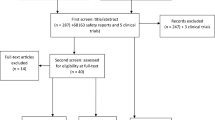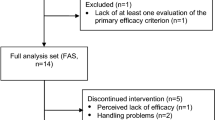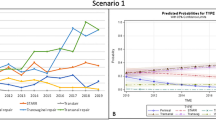Abstract
Purpose
Transanal irrigation is increasingly used against chronic constipation and fecal incontinence in selected patients. The aims were to estimate the incidence of irrigation-related bowel perforation in patients using the Peristeen Anal Irrigation® system, and to explore patient- and procedure-related factors associated with perforation.
Methods
External independent expert audit on the complete set of global vigilance data related to Peristeen Anal Irrigation from 2005 to 2013.
Results
In total, 49 reports of bowel perforation had been recorded. Based on sales figures, this corresponds to an average risk of bowel perforation of 6 per million procedures. The latest two-year data indicate a risk of 2 per million procedures. In 29 out of 43 evaluable cases (67 %), perforation happened within the first 8 weeks since start of treatment. After 8 weeks, long-term use has an estimated risk of less than 2 per million procedures. Among patients with non-neurogenic bowel dysfunction, 11 out of 15 (73 %) had a history of pelvic organ surgery compared to 5 out of 26 (19 %) in neurogenic bowel dysfunction. In 11 of 46 (24 %) evaluable cases, burst of the rectal balloon was reported.
Conclusion
Enema-induced perforation is a rare complication to transanal irrigation with Peristeen Anal Irrigation, which increases the benefit risk ratio in support of the further use of transanal irrigation. Increased risk is present during treatment initiation and in patients with prior pelvic organ surgery. Careful patient selection, patient evaluation and proper training of patients are critical to safe practice of this technique.



Similar content being viewed by others
References
Shandling B, Gilmour RF (1987) The enema continence catheter in spina bifida: successful bowel management. J Pediatr Surg 22:271–273
Christensen P, Bazzocchi G, Coggrave M et al (2006) A randomized, controlled trial of transanal irrigation versus conservative bowel management in spinal cord-injured patients. Gastroenterology 131:738–747
Emmanuel AV, Krogh K, Bazzocchi G et al (2013) Consensus review of best practice of transanal irrigation in adults. Spinal Cord 51:732–738
Christensen P, Olsen N, Krogh K, Bacher T, Laurberg S (2003) Scintigraphic assessment of retrograde colonic washout in fecal incontinence and constipation. Dis Colon Rectum 46:68–76
Christensen P, Krogh K, Buntzen S, Payandeh F, Laurberg S (2009) Long-term outcome and safety of transanal irrigation for constipation and fecal incontinence. Dis Colon Rectum 52:286–292
Preziosi G, Gosling J, Raeburn A, Storrie J, Panicker J, Emmanuel A (2012) Transanal irrigation for bowel symptoms in patients with multiple sclerosis. Dis Colon Rectum 55:1066–1073
Rosen H, Robert-Yap J, Tentschert G, Lechner M, Roche B (2011) Transanal irrigation improves quality of life in patients with low anterior resection syndrome. Colorectal Dis 13:e335–e338
Meyboom RH, Hekster YA, Egberts AC, Gribnau FW, Edwards IR (1997) Causal or casual? The role of causality assessment in pharmacovigilance. Drug Saf 17:374–389
Atkin WS, Cook CF, Cuzick J, Edwards R, Northover JM, Wardle J (2002) Single flexible sigmoidoscopy screening to prevent colorectal cancer: baseline findings of a UK multicentre randomised trial. Lancet 359:1291–1300
Loffeld RJ, Engel A, Dekkers PE (2011) Incidence and causes of colonoscopic perforations: a single-center case series. Endoscopy 43:240–242
Gedebou TM, Wong RA, Rappaport WD, Jaffe P, Kahsai D, Hunter GC (1996) Clinical presentation and management of iatrogenic colon perforations. Am J Surg 172:454–457
Iversen LH, Ingeholm P, Gogenur I, Laurberg S (2014) Major reduction in 30-day mortality after elective colorectal cancer surgery: a nationwide population-based study in Denmark 2001–2011. Ann Surg Oncol 21:2267–2273
Billeter AT, Polk HC Jr, Hohmann SF et al (2012) Mortality after elective colon resection: the search for outcomes that define quality in surgical practice. J Am Coll Surg 214:436–443 (discussion 43-44)
Gayer G, Zissin R, Apter S, Oscadchy A, Hertz M (2002) Perforations of the rectosigmoid colon induced by cleansing enema: CT findings in 14 patients. Abdom Imaging 27:453–457
Memon S, Bissett IP (2014) Rectal perforation following transanal irrigation. ANZ J Surg. doi:10.1111/ans.12761
Iversen LH, Bulow S, Christensen IJ, Laurberg S, Harling H (2008) Postoperative medical complications are the main cause of early death after emergency surgery for colonic cancer. Br J Surg 95:1012–1049
Paran H, Butnaru G, Neufeld D, Magen A, Freund U (1999) Enema-induced perforation of the rectum in chronically constipated patients. Dis Colon Rectum 42:1609–1612
Biering-Sorensen F, Bing J, Berggreen P, Olesen GM (2009) Rectum perforation during transanal irrigation: a case story. Spinal Cord 47:266–267
Emmertsen KJ, Laurberg S (2012) Low anterior resection syndrome score: development and validation of a symptom-based scoring system for bowel dysfunction after low anterior resection for rectal cancer. Ann Surg 255:922–928
Funding
The study has not been financially supported.
Author information
Authors and Affiliations
Corresponding author
Ethics declarations
Conflicts of interest
Peter Christensen has served as a consultant and an advisory board member for Coloplast, and as an advisory board member for Wellspect Health Care. Klaus Krogh has served as an advisory board member for Coloplast and Wellspect Health Care. Brigitte Perrouin-Verbe has served as an advisory board member for Coloplast. Dietrich Leder has served as an advisory board member for Coloplast and Wellspect Health Care. Gabriele Bazzocchi has served as an advisory board member for Coloplast and Wellspect Health Care. Birte Petersen Jakobsen is an employee of Coloplast. Anton Emmanuel has served as a speaker, a consultant and an advisory board member for Coloplast, Hollister and Wellspect Health Care.
Ethical approval
This article does not contain any studies with human participants or animals performed by any of the authors.
Informed consent
For this type of study formal consent is not required.
Rights and permissions
About this article
Cite this article
Christensen, P., Krogh, K., Perrouin-Verbe, B. et al. Global audit on bowel perforations related to transanal irrigation. Tech Coloproctol 20, 109–115 (2016). https://doi.org/10.1007/s10151-015-1400-8
Received:
Accepted:
Published:
Issue Date:
DOI: https://doi.org/10.1007/s10151-015-1400-8




